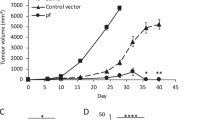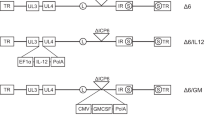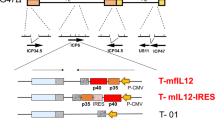Abstract
The Semliki Forest virus (SFV) vector is an RNA-based suicide expression vector that has been used experimentally for tumour therapy. Recently, a new enhanced vector pSFV10-E has been developed that expresses foreign genes at levels up to 10 times higher than the original vector. Interleukin-12 (IL-12), an immunomodulatory cytokine, plays a key role in the induction of T-helper1 responses. The two IL-12 gene subunits were cloned from mouse splenocytes and inserted into the pSFV10-E and pSFV10 (nonenhanced) vectors. Both constructs expressed and secreted biologically active murine IL-12. Administration of high titre rSFV10-E-IL12 particles intratumourally to treat implanted K-BALB tumours in BALB/c mice demonstrated complete tumour regression in comparison to control or rSFV10-IL12 treated groups. High titre rSFV10-E-IL12 particles were also effective in the CT26 tumour model. Histological and immunohistochemical studies revealed tumour necrosis in addition to aggressive influx of CD4+ and CD8+ T cells and other immune cells. Furthermore, inhibition of primary tumour growth and lung metastases of a metastatic (4T1) tumour model indicated the potential of high titres of rSFV10-E-IL12 particles as an efficient antitumour therapeutic agent.
This is a preview of subscription content, access via your institution
Access options
Subscribe to this journal
Receive 12 print issues and online access
$259.00 per year
only $21.58 per issue
Buy this article
- Purchase on Springer Link
- Instant access to full article PDF
Prices may be subject to local taxes which are calculated during checkout







Similar content being viewed by others
References
Karlsson GB, Liljestrom P . Delivery and expression of heterologous genes in mammalian cells using self-replicating alphavirus vectors. Methods Mol Biol 2004; 246: 543–557.
Lundstrom K . Alphavirus vectors for gene therapy applications. Curr Gene Ther 2001; 1: 19–29.
Lundstrom K . Alphavirus vectors for vaccine production and gene therapy. Expert Rev Vaccines 2003; 2: 447–459.
Rayner JO, Dryga SA, Kamrud KI . Alphavirus vectors and vaccination. Rev Med Virol 2002; 12: 279–296.
Lundstrom K et al. Semliki Forest virus vectors: efficient vehicles for in vitro and in vivo gene delivery. FEBS Lett 2001; 504: 99–103.
Glasgow GM et al. The Semliki Forest virus vector induces p53-independent apoptosis. J Gen Virol 1998; 79 (Part 10): 2405–2410.
Murphy AM, Morris-Downes MM, Sheahan BJ, Atkins GJ . Inhibition of human lung carcinoma cell growth by apoptosis induction using Semliki Forest virus recombinant particles. Gene Therapy 2000; 7: 1477–1482.
Berglund P et al. Semliki Forest virus expression system: production of conditionally infectious recombinant particles. Biotechnology 1993; 11: 916–920.
Smerdou C, Liljeström P . Two-helper RNA system for production of recombinant Semliki Forest virus particles. J Virol 1999; 73: 1092–1098.
Atkins GJ et al. Alphaviruses and their derived vectors as anti-tumor agents. Curr Cancer Drug Targets 2004; 4: 597–607.
Zhang J et al. Cloning of human IL-12 p40 and p35 DNA into the Semliki Forest virus vector: expression of IL-12 in human tumor cells. Gene Therapy 1997; 4: 367–374.
Yamanaka R et al. Induction of an antitumor immunological response by an intratumoural injection of dendritic cells pulsed with genetically engineered Semliki Forest virus to produce interleukin-18 combined with the systemic administration of interleukin-12. J Neurosurg 2003; 99: 746–753.
Colmenero P et al. Immunotherapy with recombinant SFV-replicons expressing the P815A tumor antigen or IL-12 induces tumor regression. Int J Cancer 2002; 98: 554–560.
Colmenero P, Liljestrom P, Jondal M . Induction of P815 tumor immunity by recombinant Semliki Forest virus expressing the P1A gene. Gene Therapy 1999; 6: 1728–1733.
Morris-Downes MM et al. Semliki Forest virus-based vaccines: persistence, distribution and pathological analysis in two animal systems. Vaccine 2001; 19: 1978–1988.
Fleeton MN, Liljestrom P, Sheahan BJ, Atkins GJ . Recombinant Semliki Forest virus particles expressing louping ill virus antigens induce a better protective response than plasmid-based DNA vaccines or an inactivated whole particle vaccine. J Gen Virol 2000; 81: 749–758.
Jerusalmi A, Morris-Downes MM, Sheahan BJ, Atkins GJ . Effect of intranasal administration of Semliki Forest virus recombinant particles expressing reporter and cytokine genes on the progression of experimental autoimmune encephalomyelitis. Mol Ther 2003; 8: 886–894.
Asselin-Paturel C et al. Transfer of the murine interleukin-12 gene in vivo by a Semliki Forest virus vector induces B16 tumor regression through inhibition of tumor blood vessel formation monitored by Doppler ultrasonography. Gene Therapy 1999; 6: 606–615.
Ren H et al. Immunogene therapy of recurrent glioblastoma multiforme with a liposomally encapsulated replication-incompetent Semliki forest virus vector carrying the human interleukin-12 gene–a phase I/II clinical protocol. J Neurooncol 2003; 64: 147–154.
Sjoberg EM, Suomalainen M, Garoff H . A significantly improved Semliki Forest virus expression system based on translation enhancer segments from the viral capsid gene. Biotechnology 1994; 12: 1127–1131.
Colombo MP et al. Amount of Interleukin 12 available at the tumour site is critical for tumour regression. Cancer Res 1996; 56: 2531–2534.
Trinchieri G . Interleukin-12: a proinflmmatory cytokine with immuno-regulatory functions that bridge innate resistance and antigen-specific adaptive immunity. Ann Rev Immunol 1995; 13: 251–276.
Manetti R et al. Interleukin 12 induces stable priming for interferon gamma (IFN-gamma) production during differentiation of human T helper (Th) cells and transient IFN-gamma production in established Th2 cell clones. J Exp Med 1994; 179: 1273–1283.
Sgadari C, Angiolillo AL, Tosato G . Inhibition of angiogenesis by interleukin-12 is mediated by the interferon-inducible protein 10. Blood 1996; 87: 3877–3882.
Sridhar SS, Shepherd FA . Targeting angiogenesis: a review of angiogenesis inhibitors in the treatment of lung cancer. Lung Cancer 2003; 42: S81–S91.
Aaronson SA, Weaver CA . Characterization of murine sarcoma virus (Kirsten) transformation of mouse and human cells. J Gen Virol 1971; 13: 245–252.
Stephenson JR, Aaronson SA . Antigenic properties of murine sarcoma virus transformed BALB-3T3 nonproducer cells. J Exp Med 1972; 135: 503–515.
Brattain MG et al. Establishment of mouse colonic carcinoma cell lines with different metastatic properties. Cancer Res 1980; 40: 2142–2146.
Wang M et al. Active immunotherapy of cancer with a nonreplicating recombinant fowlpox virus encoding a model tumor-associated antigen. J Immunol 1995; 154: 4685–4692.
Smyth JW, Fleeton MN, Sheahan BJ, Atkins GJ . Treatment of rapidly growing K-BALB and CT26 mouse tumours using Semliki Forest virus and its derived vector. Gene Therapy 2005; 12: 147–159.
Aslakson CJ, Miller FR . Selective events in the metastatic process defined by analysis of the sequential dissemination of subpopulations of a mouse mammary tumor. Cancer Res 1992; 52: 1399–1405.
Pulaski BA, Ostrand-Rosenberg S . Reduction of established spontaneous mammary carcinoma metastases following immunotherapy with major histocompatibility complex class II and B7.1 cell-based tumor vaccines. Cancer Res 1998; 58: 1486–1493.
Thomas DL, Fraser, NW . HSV-1 Therapy of primary tumors reduces the number of metastases in an immune-competent model of metastatic breast cancer. Mol Ther 2003; 8: 543–551.
Gao JQ et al. A single intratumoral injection of a fiber-mutant adenoviral vector encoding interleukin 12 induces remarkable anti-tumor and anti-metastatic activity in mice with Meth-A fibrosarcoma. Biochem Biophys Res Commun 2005; 328: 1043–1050.
Toda M, Martuza RL, Kojima H, Rabkin SD . In situ cancer vaccination: an IL-12 defective vector/replication-competent herpes simplex virus combination induces local and systemic antitumor activity. J Immunol 1998; 160: 4457–4464.
Brunda MJ et al. Antitumor and antimetastatic activity of interleukin 12 against murine tumors. J Exp Med 1993; 178: 1223–1230.
Murphy AM, Sheahan BJ, Atkins GJ . Induction of apoptosis in BCL-2-expressing rat prostate cancer cells using the Semliki Forest virus vector. Int J Cancer 2001; 94: 572–578.
Rak JW, St Croix BD, Kerbel RS . Consequences of angiogenesis for tumor progression, metastasis and cancer therapy. Anticancer Drugs 1995; 6: 3–18.
Acknowledgements
We thank Alex Whelan for assistance with histopathological studies, and Dorothy Mooney for assistance with laboratory protocols. Sareen Galbraith's advice and Christopher Logue's technical guidance contributed greatly to the project. We thank Peter Liljeström and colleagues at the Microbiology and Tumorbiology Center, Karolinska Institute, Stockholm for provision of the SFV expression vectors. This work was supported by Cancer Research Ireland, the European Union and Science Foundation Ireland.
Author information
Authors and Affiliations
Rights and permissions
About this article
Cite this article
Chikkanna-Gowda, C., Sheahan, B., Fleeton, M. et al. Regression of mouse tumours and inhibition of metastases following administration of a Semliki Forest virus vector with enhanced expression of IL-12. Gene Ther 12, 1253–1263 (2005). https://doi.org/10.1038/sj.gt.3302561
Received:
Accepted:
Published:
Issue Date:
DOI: https://doi.org/10.1038/sj.gt.3302561
Keywords
This article is cited by
-
Viral and Synthetic RNA Vector Technologies and Applications
Molecular Therapy (2016)
-
Neoadjuvant administration of Semliki Forest virus expressing interleukin-12 combined with attenuated Salmonella eradicates breast cancer metastasis and achieves long-term survival in immunocompetent mice
BMC Cancer (2015)
-
High efficiency of alphaviral gene transfer in combination with 5-fluorouracil in a mouse mammary tumor model
BMC Cancer (2014)
-
Immunotherapeutic Synergy Between Anti-CD137 mAb and Intratumoral Administration of a Cytopathic Semliki Forest Virus Encoding IL-12
Molecular Therapy (2012)
-
Semliki Forest virus biodistribution in tumor-free and 4T1 mammary tumor-bearing mice: a comparison of transgene delivery by recombinant virus particles and naked RNA replicon
Cancer Gene Therapy (2012)



